- drach09's home page
- Posts
- 2022
- 2020
- June (1)
- 2019
- 2018
- 2017
- 2016
- 2015
- 2014
- December (13)
- November (2)
- October (5)
- September (2)
- August (8)
- July (9)
- June (7)
- May (5)
- April (4)
- March (4)
- February (1)
- January (2)
- 2013
- December (2)
- November (8)
- October (5)
- September (12)
- August (5)
- July (2)
- June (3)
- May (4)
- April (8)
- March (10)
- February (9)
- January (11)
- 2012
- 2011
- October (1)
- My blog
- Post new blog entry
- All blogs
Run-11 Transverse Jets: Additional Embedding
I have supplemented the existing embedding sample with more statistics at lower partonic pT. Specifically, I have doubled the statistics from 2-5 GeV/c and tripled the statistics from 5-9 GeV/c. In the process, I discovered an error in the existing sample. The PYTHIA seeds for the existing sample were set by referencing the run numbers in a list file. Due to disc space limitations, the DAQ files were spread across two RCF discs; and for reference I created two corresponding list files. I thoughtlessly had the PYTHIA seeds set by referring separately to each file rather than from one master file. As a result, half of the PYTHIA events were repeated exactly in the existing sample. Having found this mistake, I have regenerated the second half of the existing embedding sample. Finally, in previous data-M.C. comparisons, I mistakenly compared data to matched embedding jets rather than to matched plus unmatched embedding jets. The macros have been updated to fix this mistake. The plots below reflect these changes, though, it appears to be of very little consequence.
Comparisons of Transverse Momentum Spectra
Figure 1: VPDMB
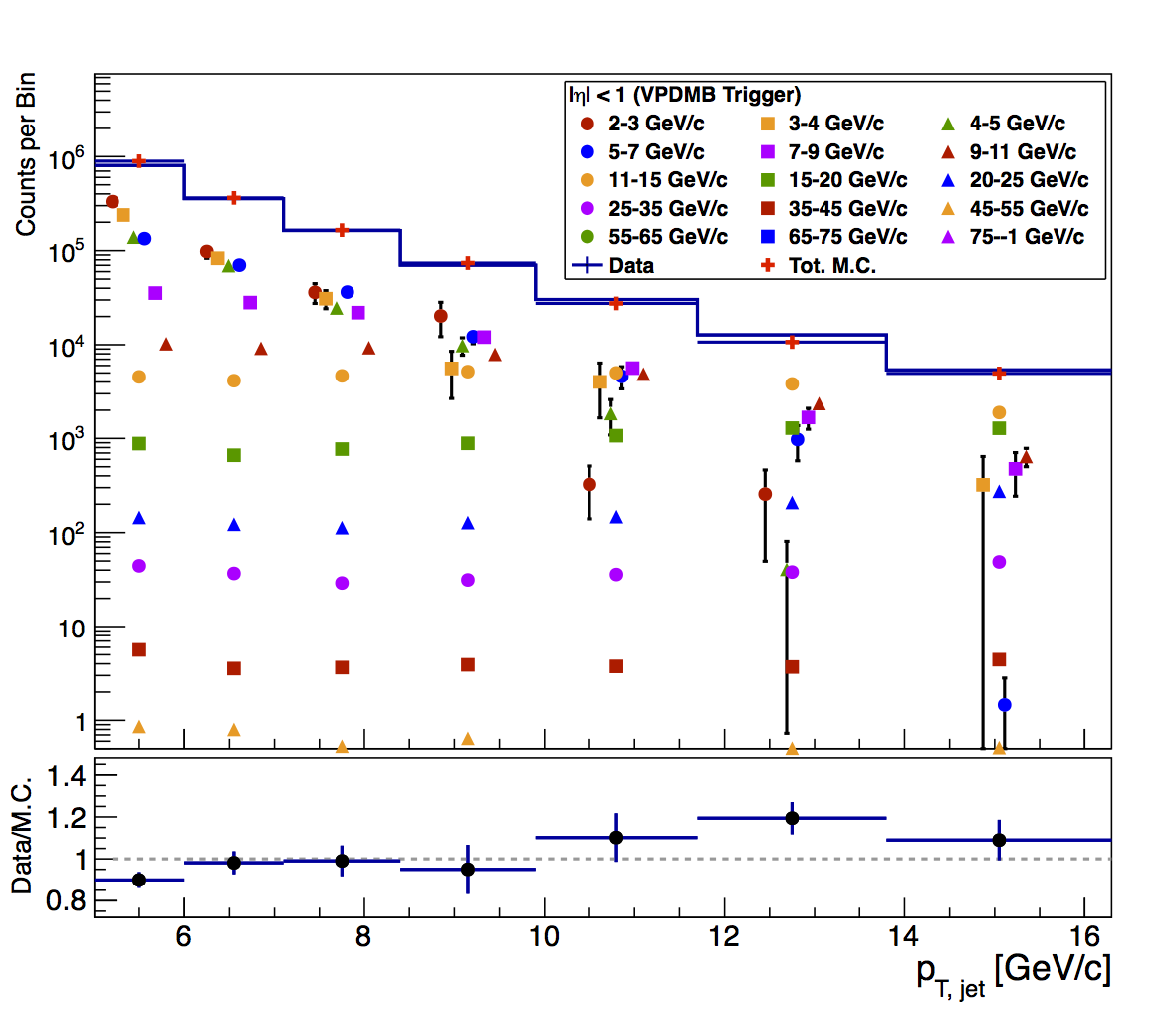
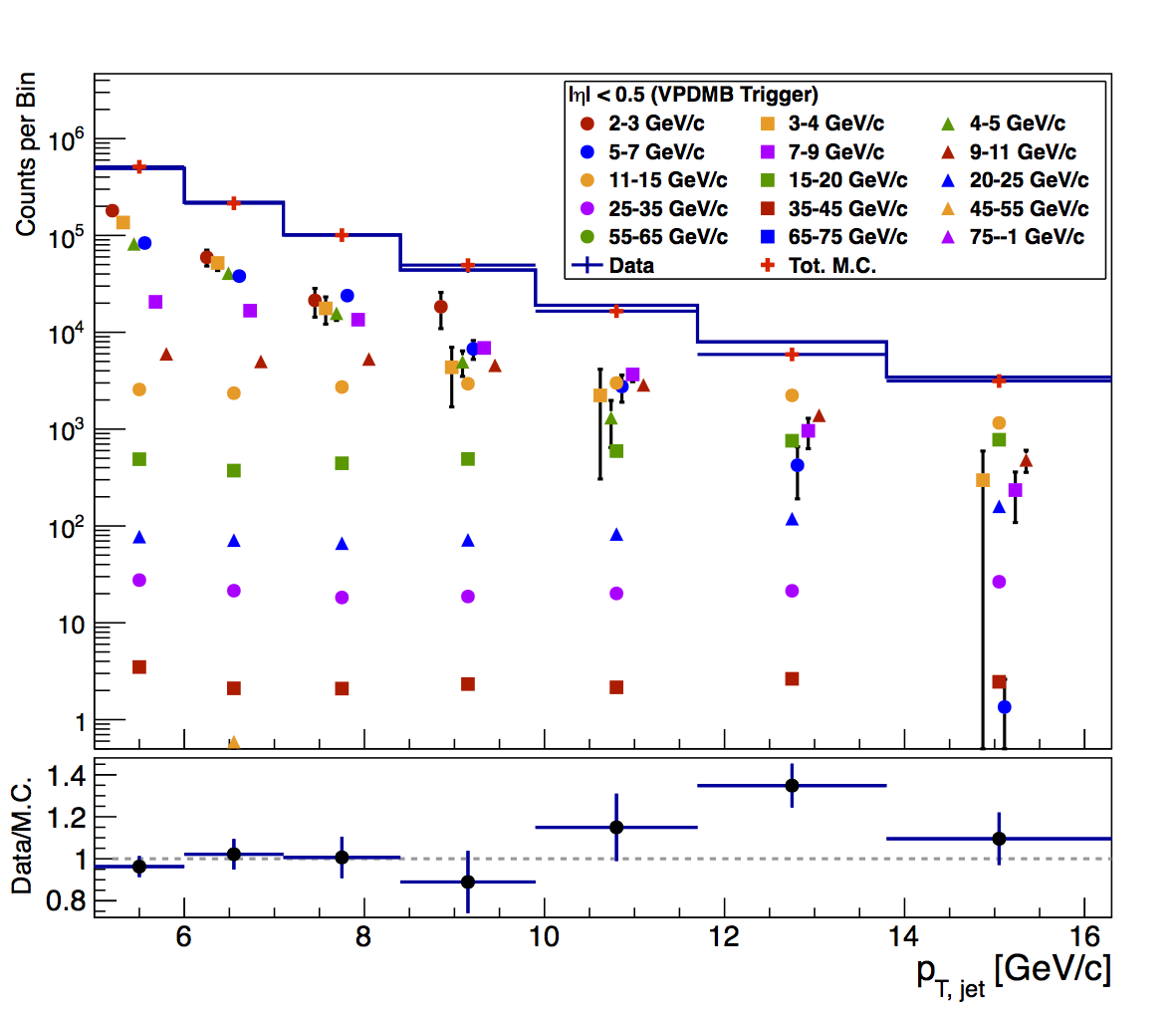

After the additional low-pT embedding and fixes, the data-to-M.C. comparisons for VPDMB are still quite good for 5-16.3 GeV/c. The embedding jets are a bit high in the 5 GeV/c bin for the "forward" sample.
Figure 2: JP0
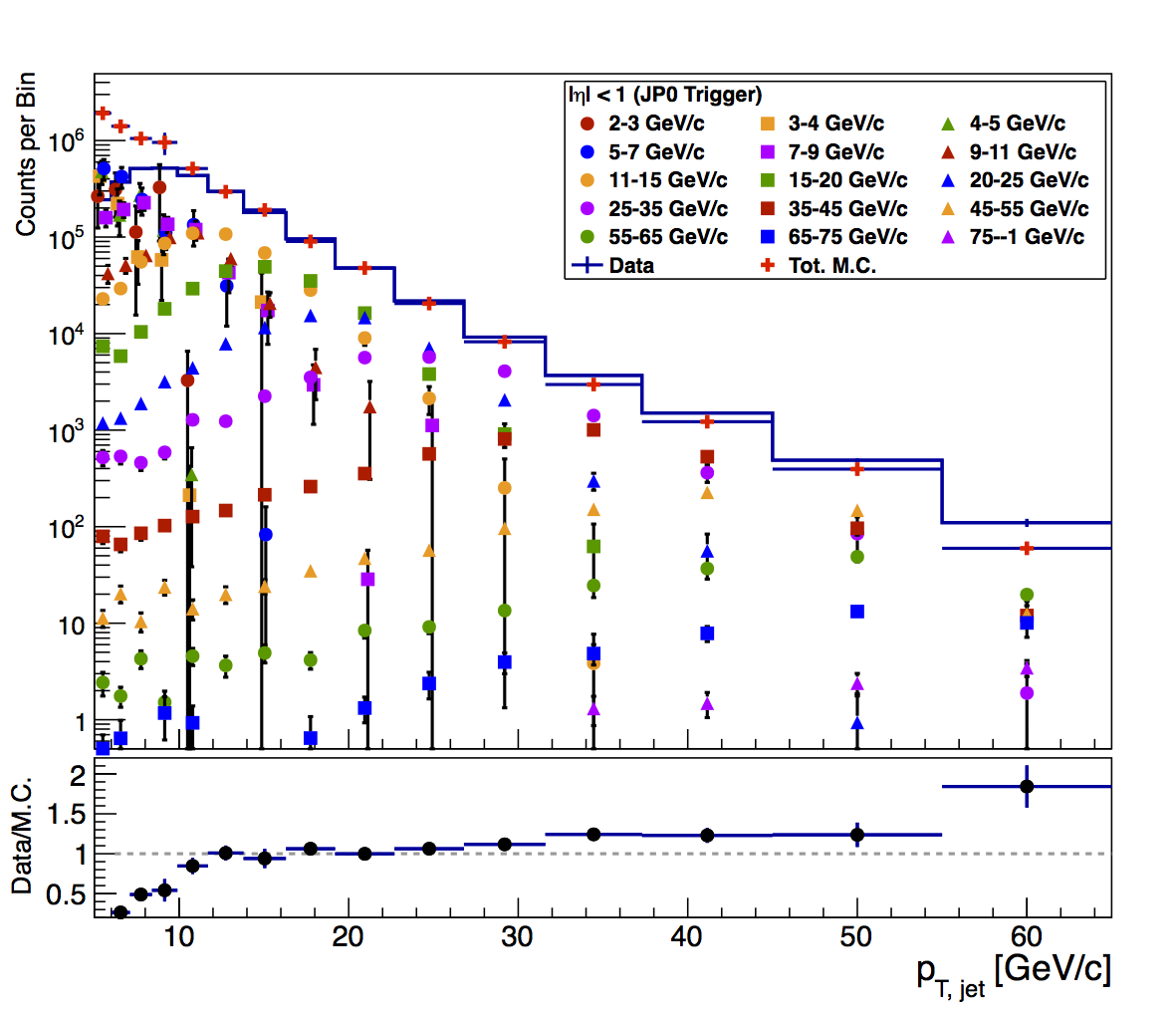
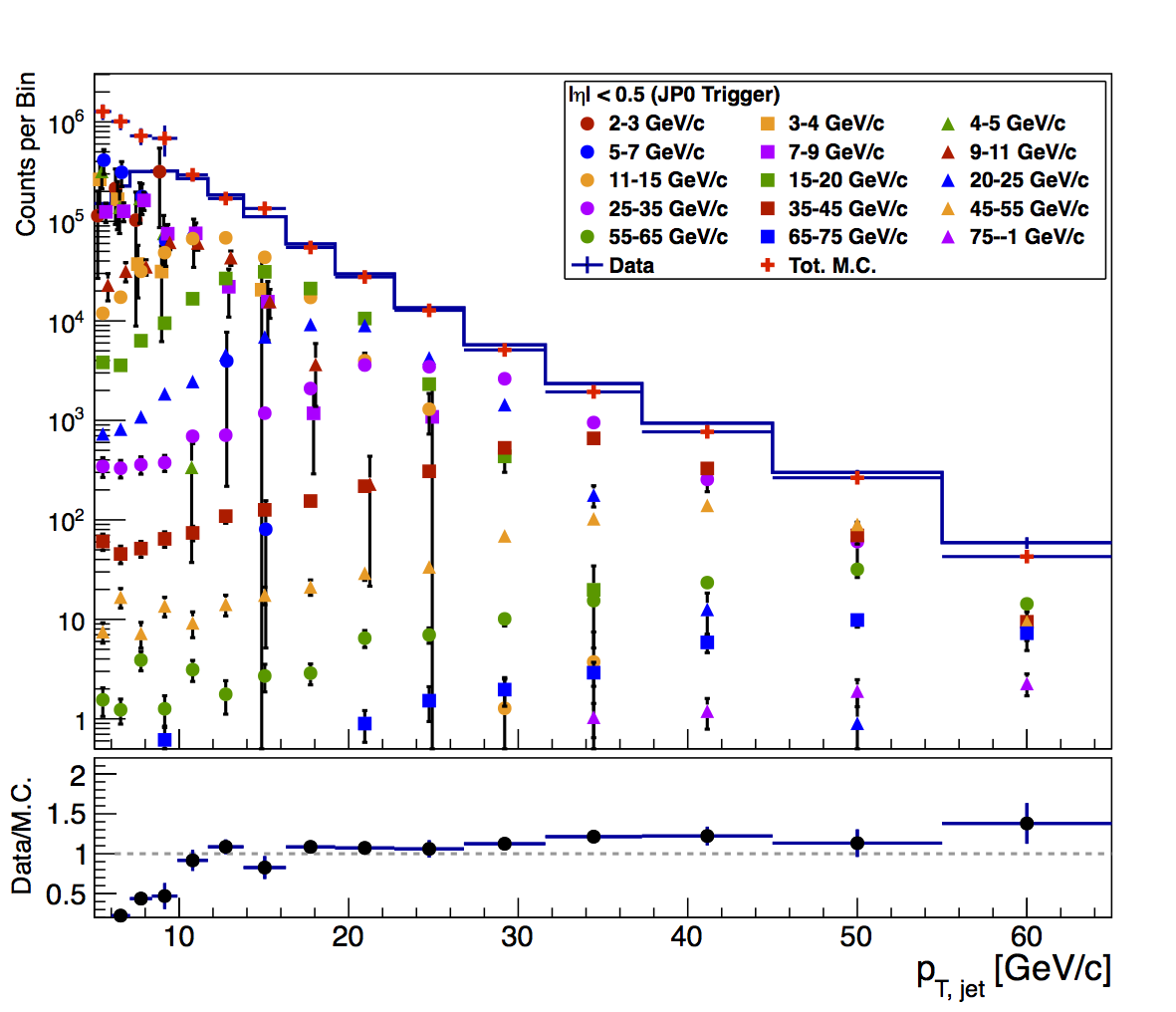

The JP0 data-to-M.C. agreement is still quite terrible near the trigger threshold, even after the fixes and additional statistics.
Figure 3: JP0 (Close-up)
.png)
.png)
.png)
In the zoomed-in view one can see that one of the issues in the lower bins is the 2-3 GeV/c partonic pT bin coming in with low statistics and high weight (e.g. the 8.4-9.9 GeV/c bin in the "mid" sample). I have doubled the size of the previous sample, so it is difficult to envision doing much more with minimum-bias embedding. This will only account for a small portion of the deviation, however. Another contributor could be the arbitrary normalization over 11.7-65 GeV/c. Otherwise, it appears that the issue may be with the trigger emulator.
Figure 4: JP1
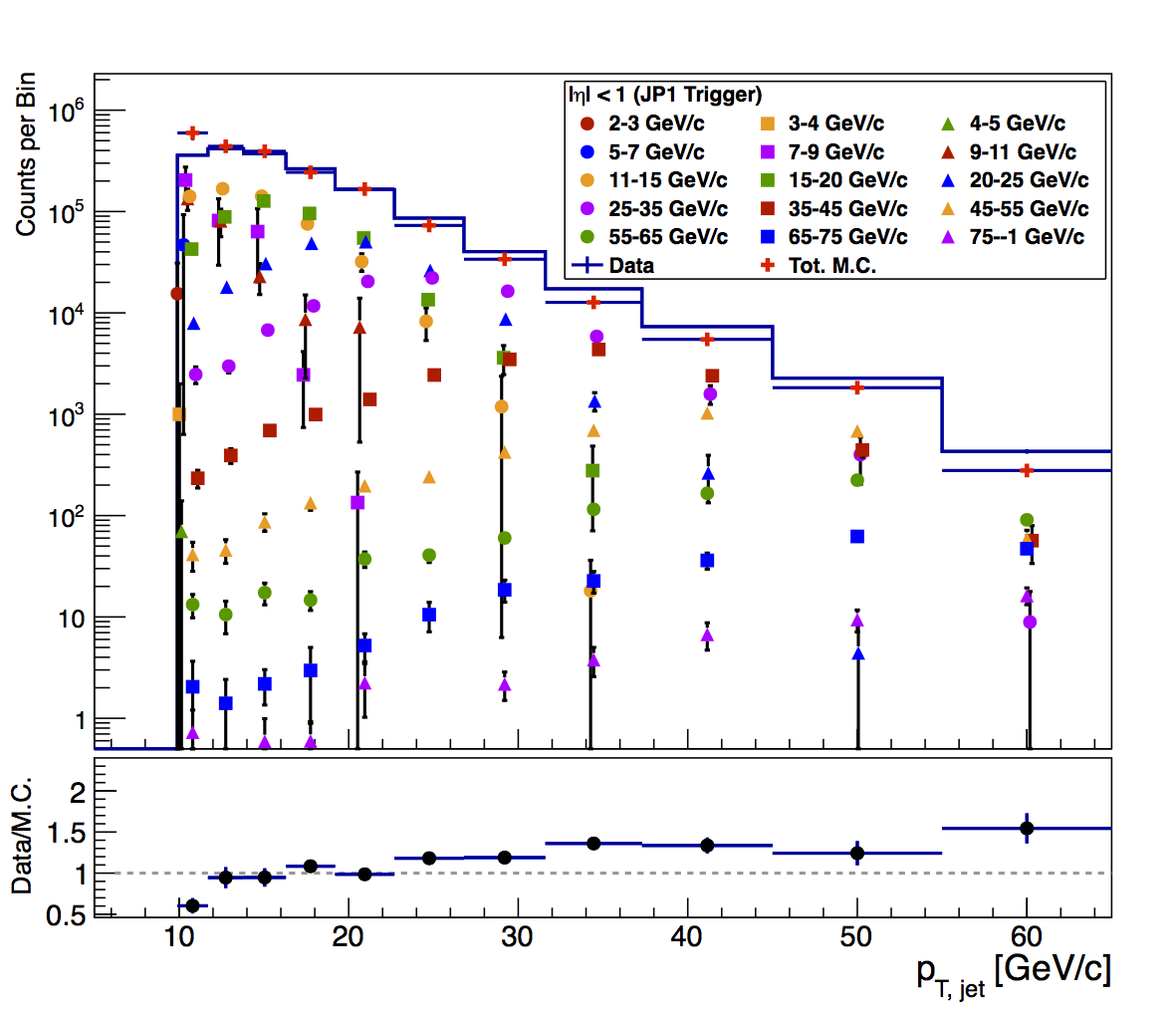
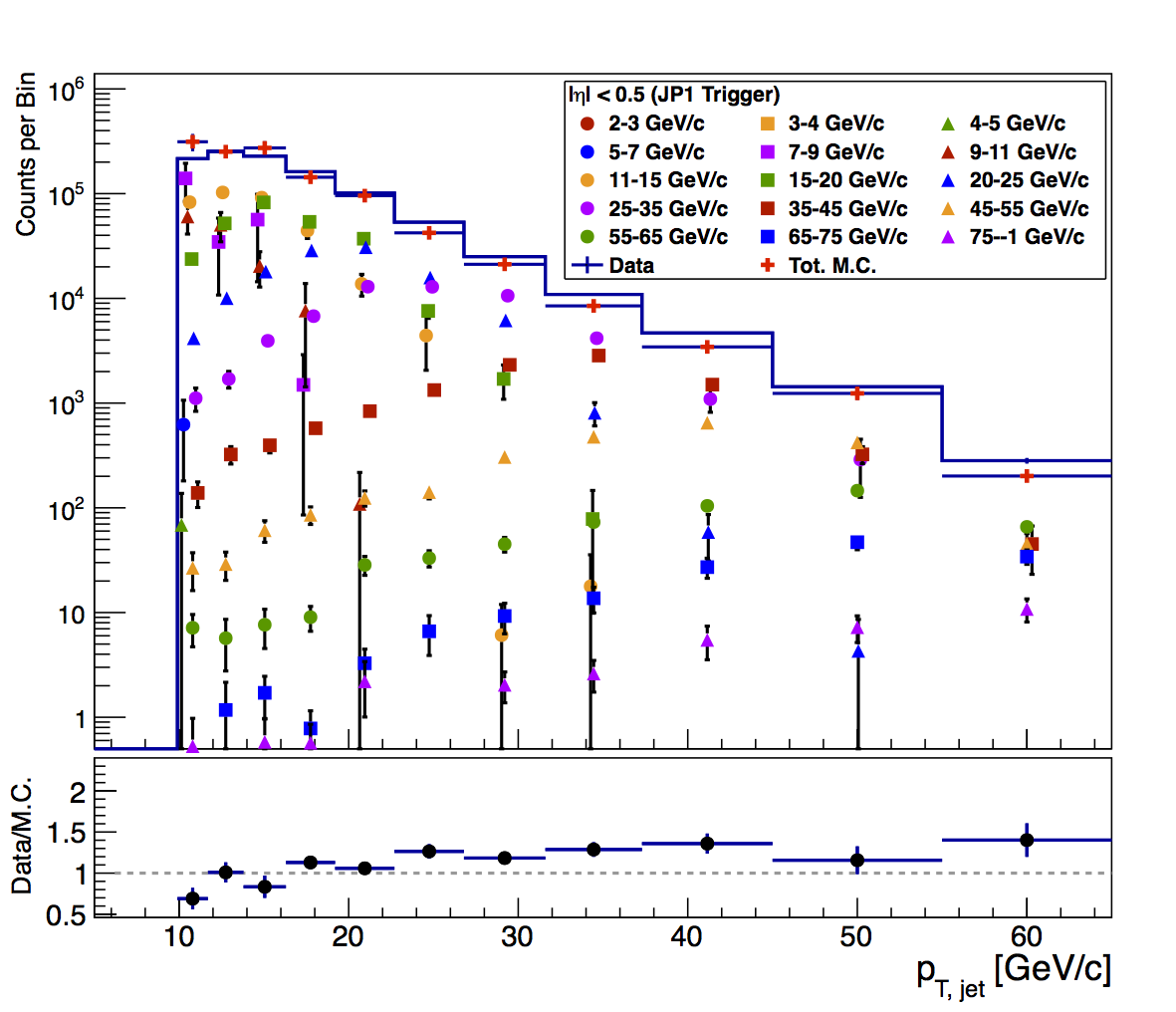
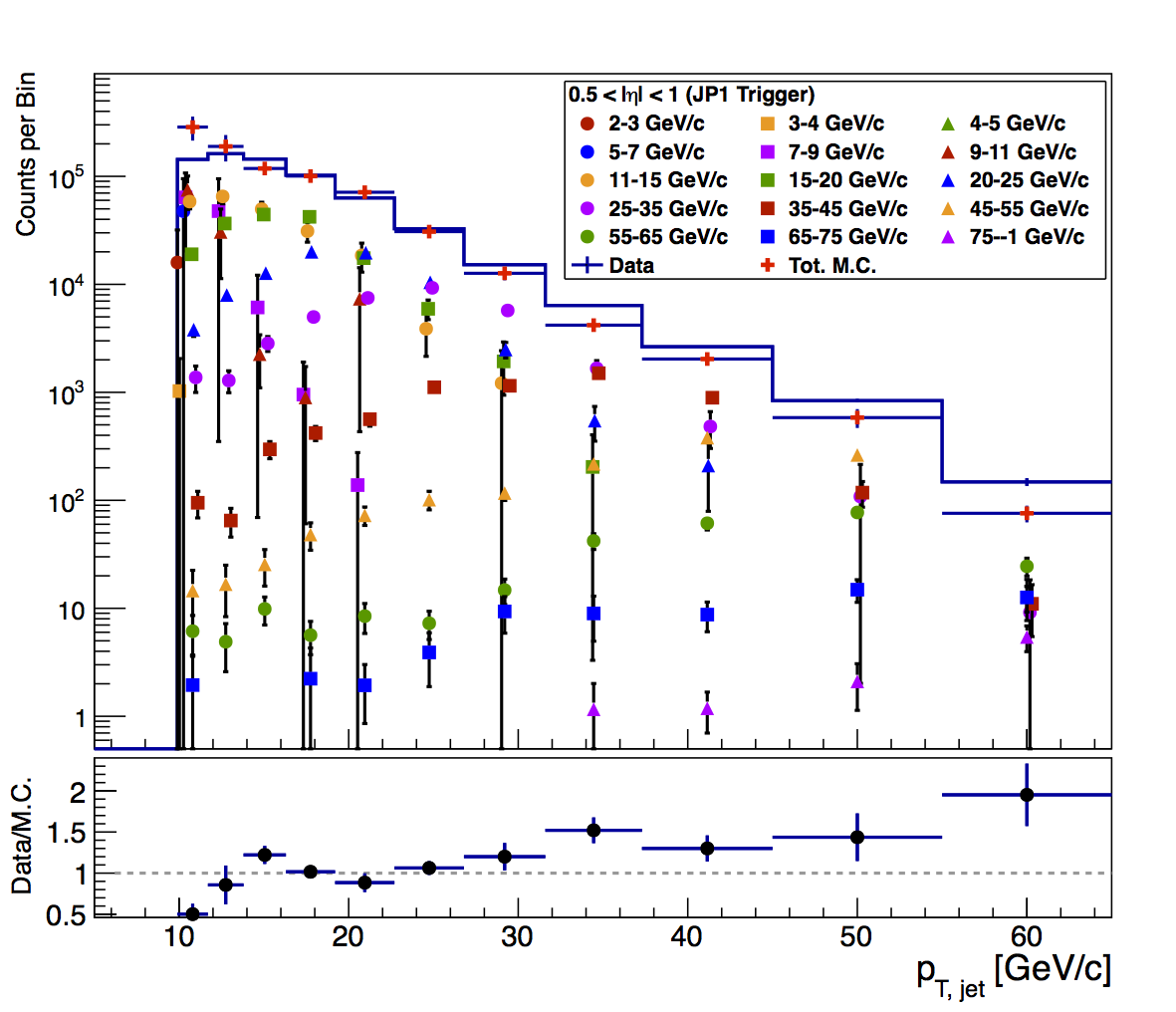
The data-M.C. agreement for JP1 is quite good above 11.7 GeV/c. The first bin above threshold, paricularly in the "forward" sample, seems to suffer a bit from unlucky statistics: one event each from partonic pT bins 2-3, 3-4, and 5-7 GeV/c, each coming with high weight. There may also be residual issues with the trigger emulator.
Figure 5: JP2
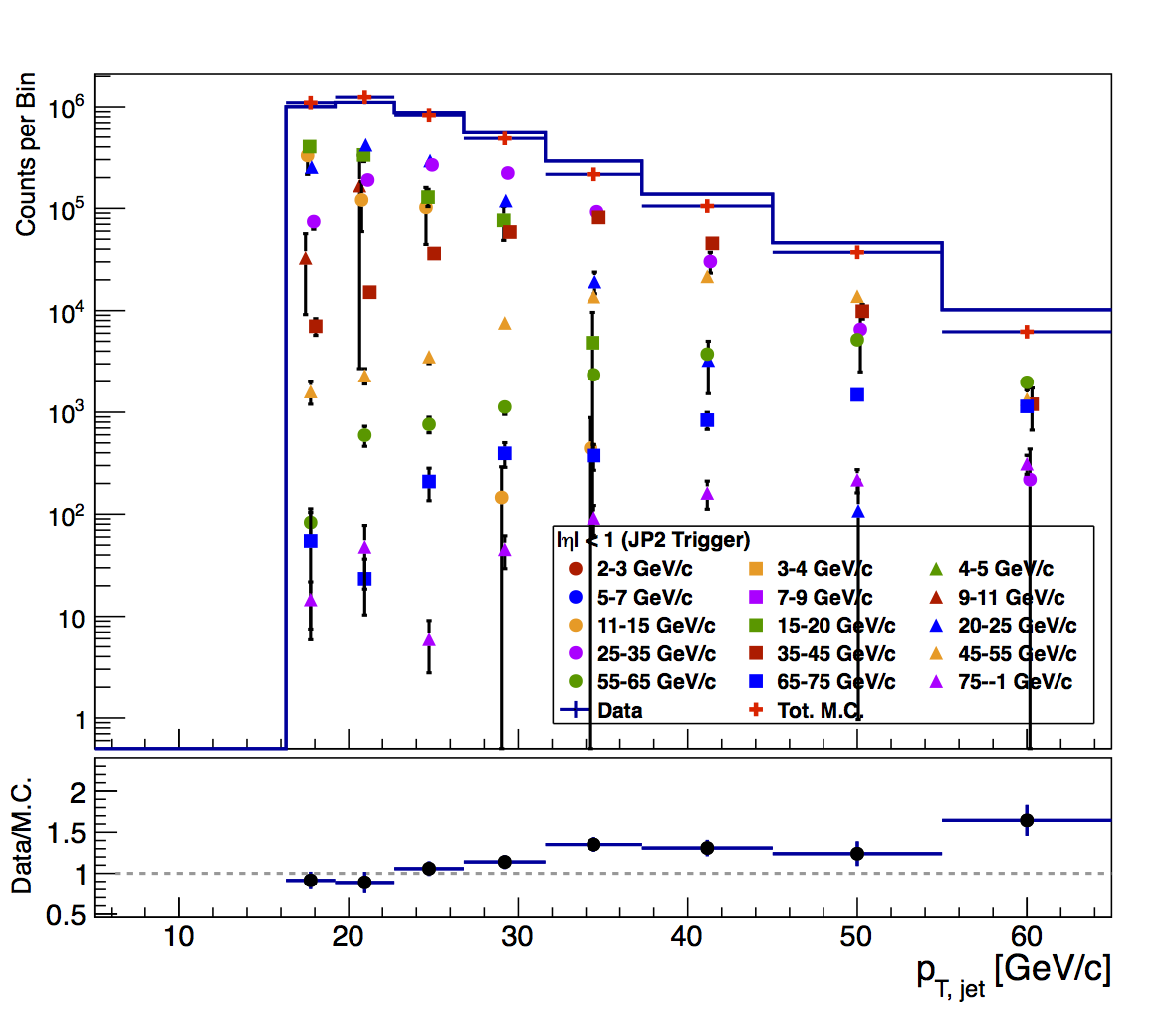
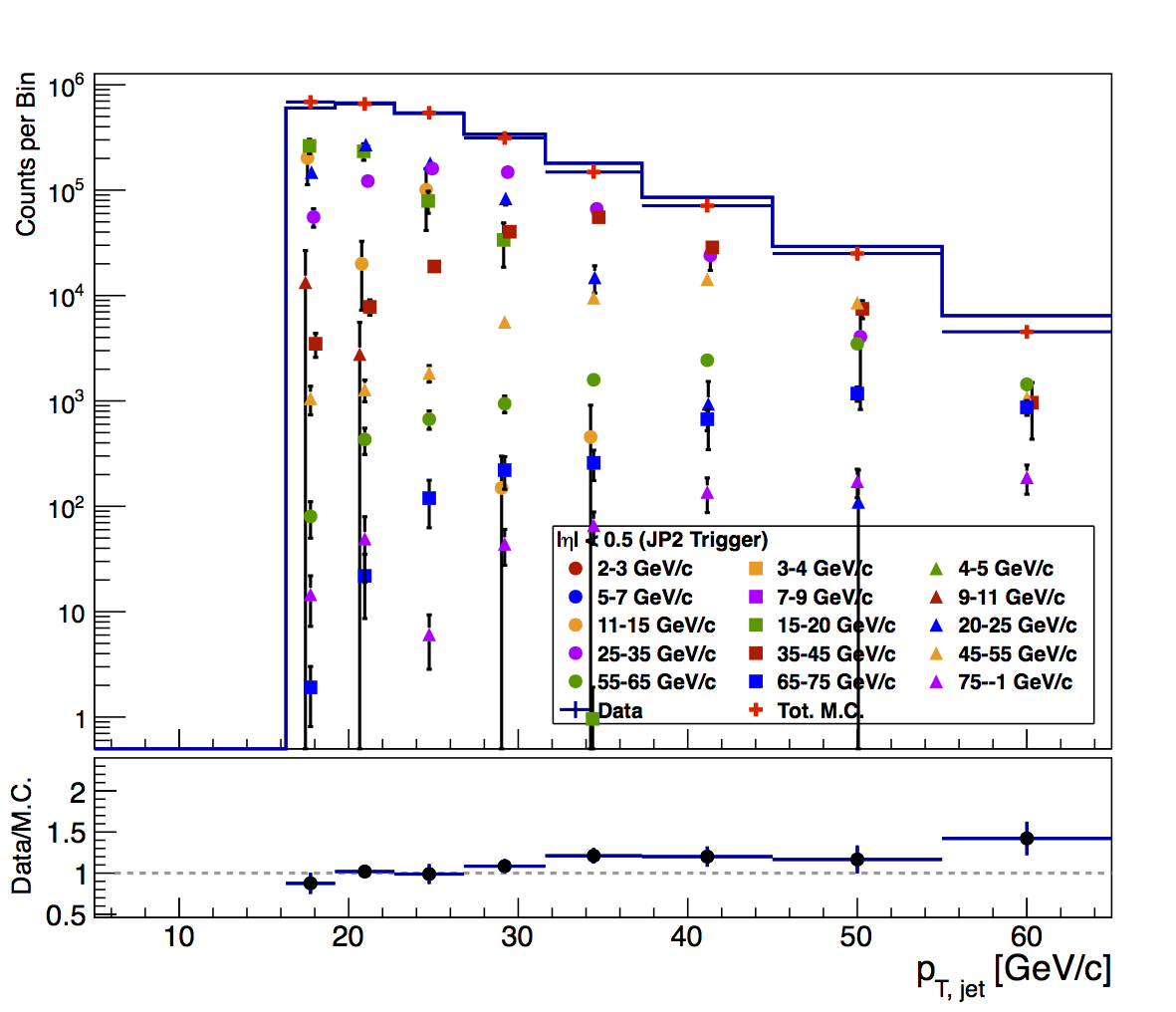
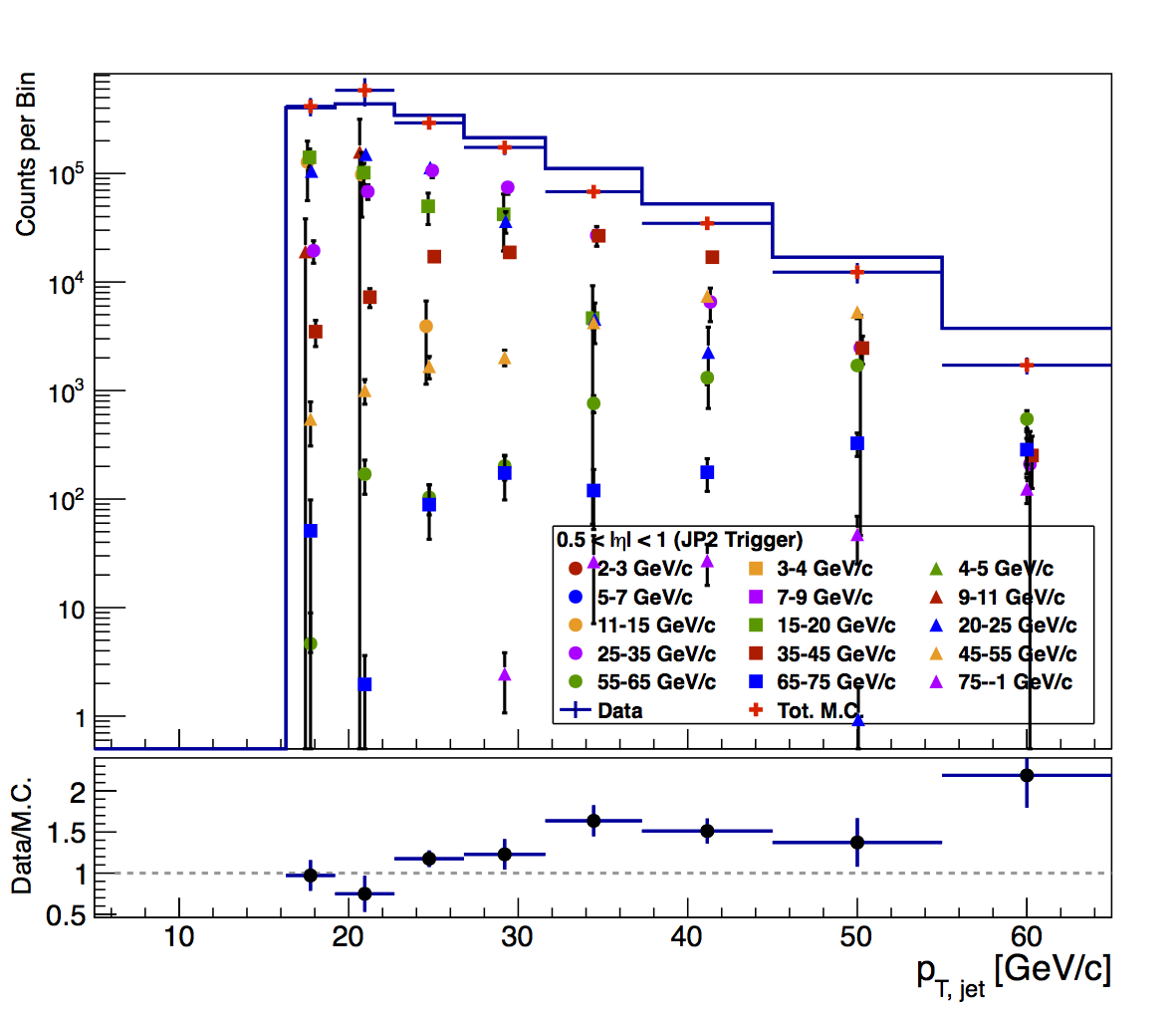
The data-M.C. comparisons for JP2 are still quite good, and seem somewhat improved at high-pT for the "mid" sample.
Matching Fractions
The dominant systematic uncertainty in the preliminary result was the matching fraction. Here, I post updated matching fractions from the new sample. The existing calculations were based upon the matching requirements from the preliminary result, and may need to be updated. The matching threshold was widened for the VPDMB sample and is probably too generous for JP triggers. The requirements for parton jets were ΔR < 1 for 5-6 GeVc, 0.9 for 6-7.1 GeV/c, 0.7 for 7.1-8.4 GeV/c, and 0.5 for the rest. For particle jets the requirements were 0.9 for 5-6 GeV/c, 0.6 for 6-7.1 GeV/c and 0.5 for the rest. I note that to this point, I have not excluded the unmatched vertices from VPDMB. Since I now require the TPC vertex match the VPD vertex for VPDMB, I can exclude this portion of the matching probability. This should improve the fractions for VPDMB.
There are three event classes contributing to the set of unmatched detector jets: detector jets from an event vertex not matched to the thrown vertex, detector jets which fail to match to a thrown particle jet, and detector jets which fail to match to a thrown parton jet. Perhaps, the first thing to check is the fraction of PYTHIA particle jets that match to a parton jet. The fraction of particle jets which fail to match to a detector jet will set an upper limit on the final matching fraction. For the PYTHIA study I required a match to be within ΔR < 0.5, independent of jet pT bin. I used the high-statistics PYTHIA sample described in previous blog entries.
Table 1: PYTHIA Particle Jets Matched to Parton Jets
| Particle Jet pT [GeV/c] | Match Fraction (Mid) | Match Fraction (Forward) |
| 4.5-5.5 | 0.565 | 0.577 |
| 5.5-6.5 | 0.687 | 0.687 |
| 6.5-7.5 | 0.782 | 0.780 |
| 7.5-8.5 | 0.843 | 0.848 |
| 8.5-9.5 | 0.891 | 0.904 |
| 9.5-10.5 | 0.942 | 0.943 |
| 10.5-11.5 | 0.939 | 0.960 |
| 11.5-12.5 | 0.970 | 0.952 |
| 12.5-13.5 | 0.994 | 0.994 |
| 13.5-14.5 | 0.997 | 0.996 |
| 14.5-15.5 | 0.969 | 0.999 |
| 15.5-16.5 | 0.999 | 0.996 |
| 16.5-17.5 | 0.998 | 1.00 |
| 17.5-18.5 | 1.00 | 0.998 |
| 18.5-19.5 | 1.00 | 1.00 |
| 19.5-20.5 | 1.00 | 1.00 |
Indeed, one sees that a high percentage of low-pT particle jets fail to match to a parton jet. The fractions are roughly consistent across the η range. In particular, below 7.5 GeV/c, the matching fractions are already below 80%.
Figure 6: PYTHIA Jet Matching
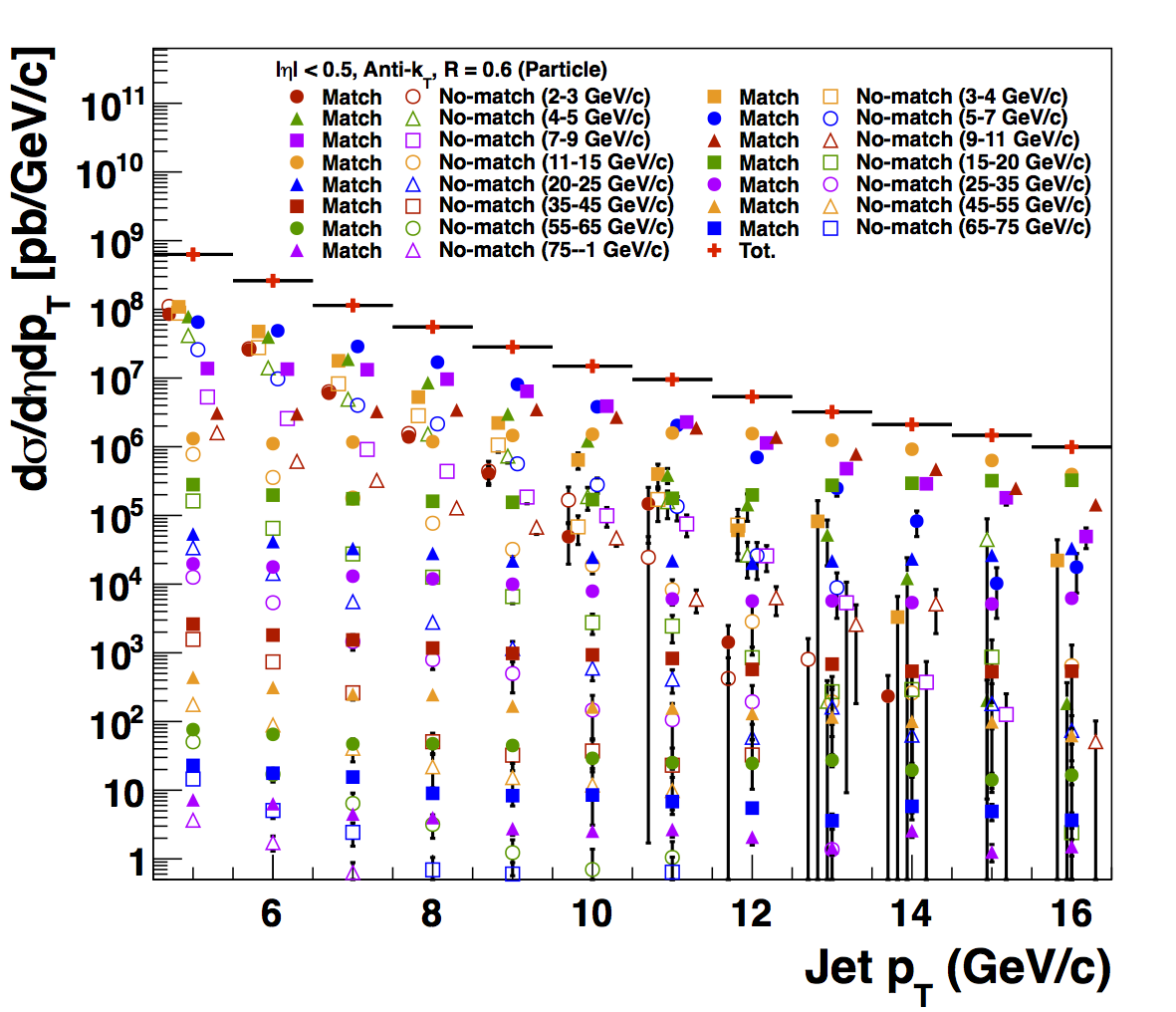
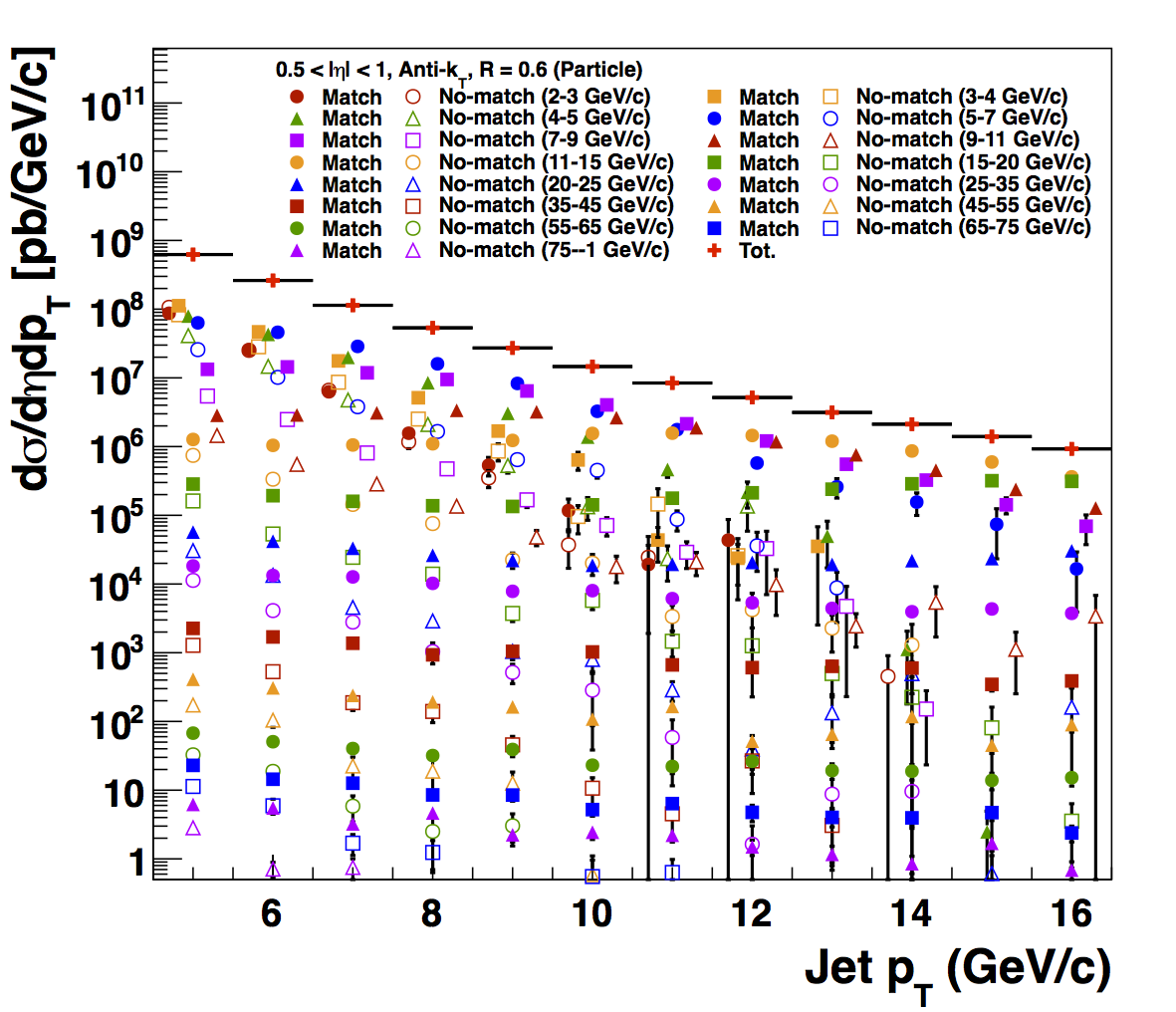
In Fig. 6 one can see that particle jets from the 2-3 GeV/c and 3-4 GeV/c bins in particular contribute a tremendous amount of unmatched jets to the total spectrum. These set an upper limit on the matching fractions at the detector level.
Table 2
| Bin [GeV/c] | VPDMB Total | VPDMB Mid | VPDMB Forward | JP0 Total | JP0 Mid | JP0 Forward | JP1 Total | JP1 Mid | JP1 Forward | JP2 Total | JP2 Mid | JP2 Forward |
| 5-6 | 0.582 | 0.569 | 0.602 | |||||||||
| 6-7.1 | 0.660 | 0.674 | 0.635 | |||||||||
| 7.1-8.4 | 0.783 | 0.766 | 0.817 | 0.717 | 0.758 | 0.952 | ||||||
| 8.4-9.9 | 0.639 | 0.553 | 0.863 | 0.536 | 0.428 | 0.837 | ||||||
| 9.9-11.7 | 0.907 | 0.930 | 0.864 | 0.938 | 0.918 | 0.967 | 0.896 | 0.858 | 0.939 | |||
| 11.7-13.8 | 0.965 | 0.984 | 0.936 | 0.998 | 0.999 | 0.997 | 0.997 | 0.998 | 0.995 | |||
| 13.8-16.3 | 0.998 | 0.998 | 0.997 | 0.998 | 0.9998 | 0.995 | 0.997 | 0.9996 | 0.992 | |||
| 16.3-19.2 | 0.999 | 0.9998 | 0.998 | 0.999 | 0.9996 | 0.998 | 0.998 | 0.998 | 0.999 | |||
| 19.2-22.7 | 0.9997 | 0.9995 | 0.9999 | 0.99994 | 0.99998 | 0.9999 | 0.99996 | 0.99994 | 0.99999 | |||
| 22.7-22.7 | 0.999991 | 0.99999 | 1 | 0.99999 | 0.99998 | 1 | 0.99997 | 0.99996 | 1 | |||
| 26.8-31.6 | 0.999 | 1 | 0.998 | 0.999 | 1 | 0.998 | 0.999 | 1 | 0.997 | |||
| 31.6-37.3 | 1 | 1 | 1 | 1 | 1 | 1 | 1 | 1 | 1 | |||
| 37.3-45 | 1 | 1 | 1 | 1 | 1 | 1 | 1 | 1 | 1 | |||
| 45-55 | 1 | 1 | 1 | 1 | 1 | 1 | 1 | 1 | 1 | |||
| 55-65 | 1 | 1 | 1 | 1 | 1 | 1 | 1 | 1 | 1 | |||
| 65-80 | 1 | 1 | 1 | 1 | 1 | 1 | 1 | 1 | 1 |
In light of the results of Table 1, the observed matching fractions for detector jets seem reasonably sensible. As a reminder, the matching requirements in Table 2 are pT-dependent, unlike in the PYTHIA study.
Figure 7: VPDMB
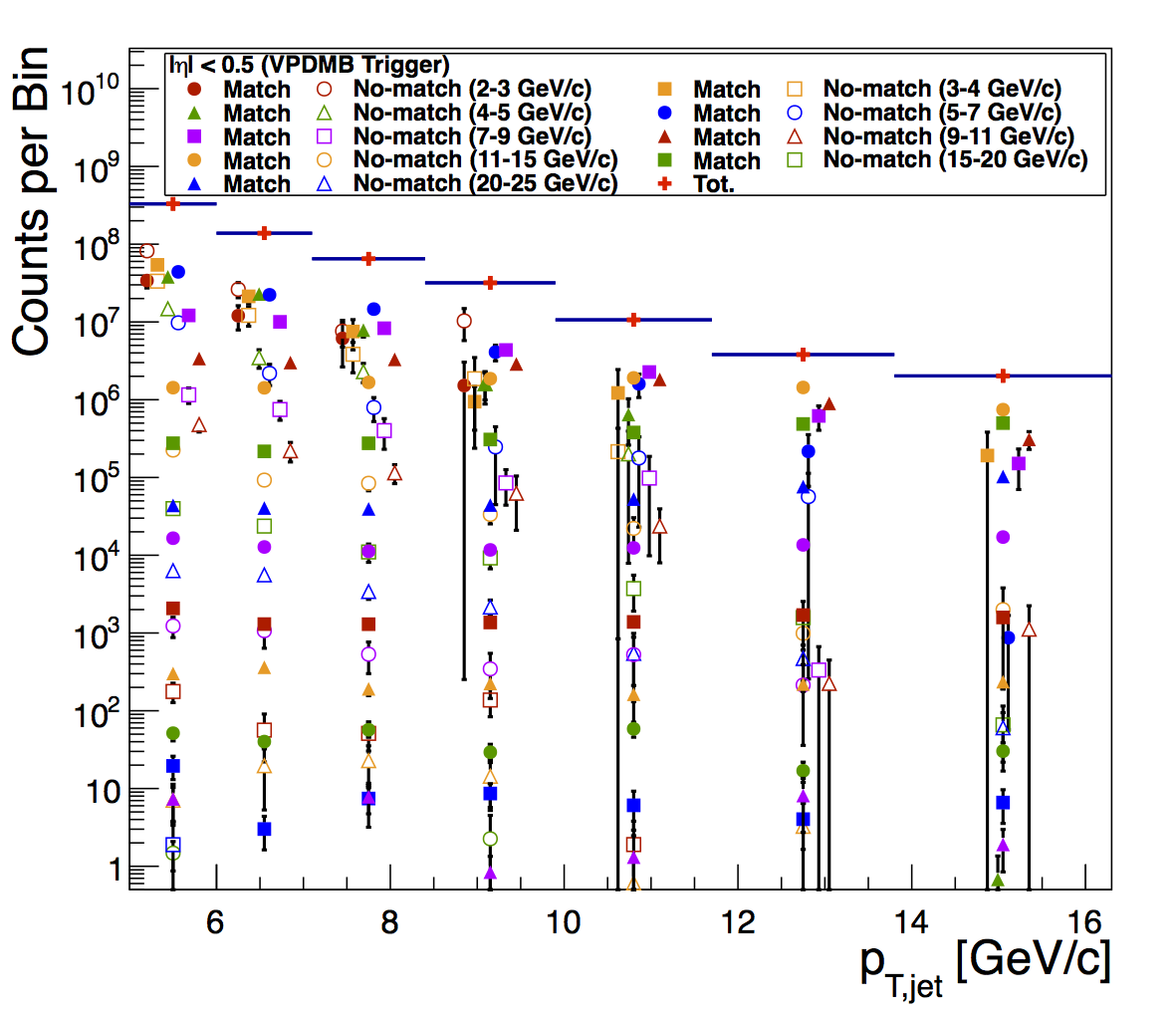
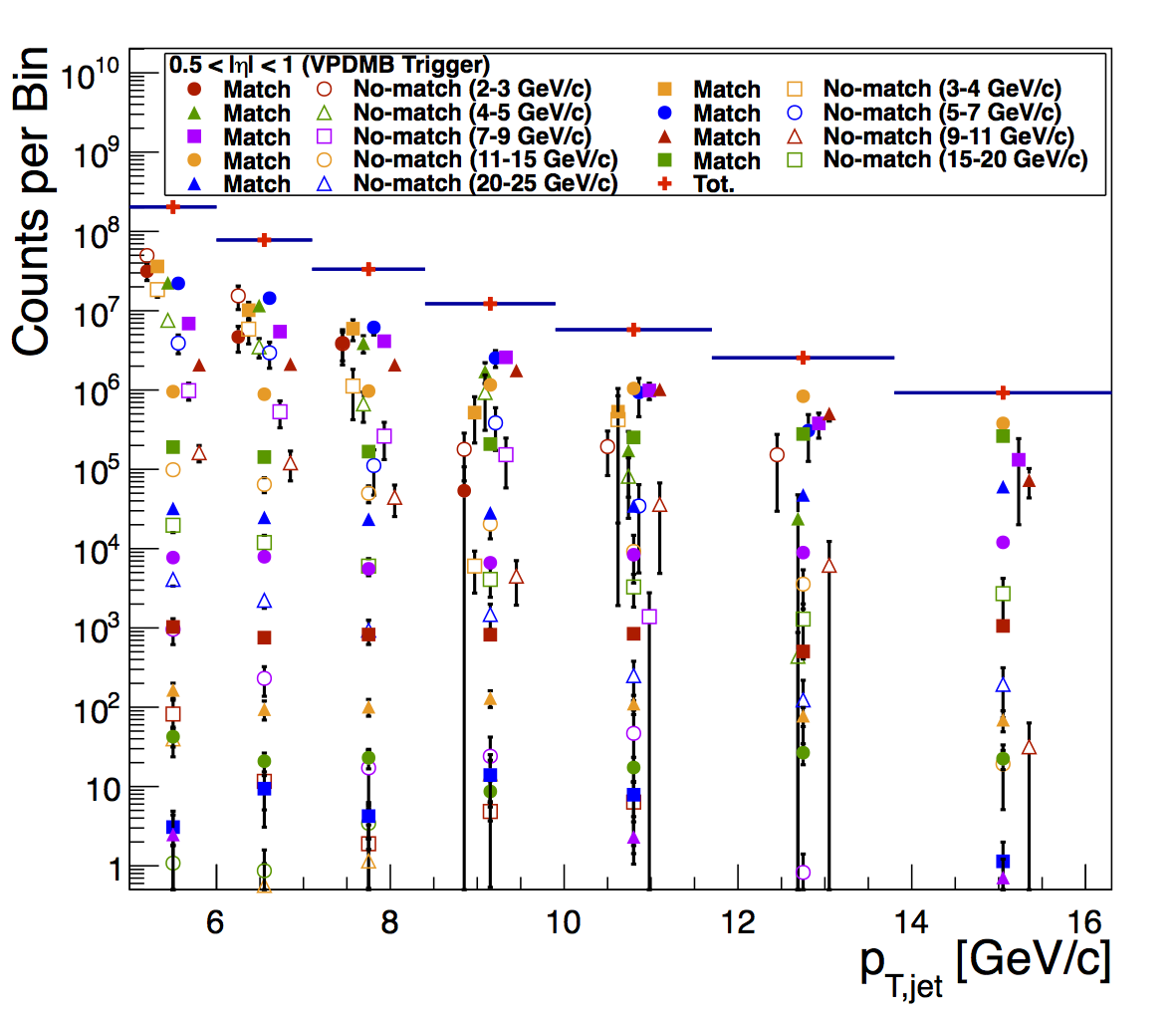
In Table 1, one can see that the low matching fraction in the 8.4-9.9 GeV/c bin is driven by the "mid" sample. In Fig. 6, one can see that this is due to the 2-3 GeV/c partonic-pT bin. It is possible this is a statistical fluctuation. I note this yield is suppressed in the "forward" sample.
Figure 8: JP0
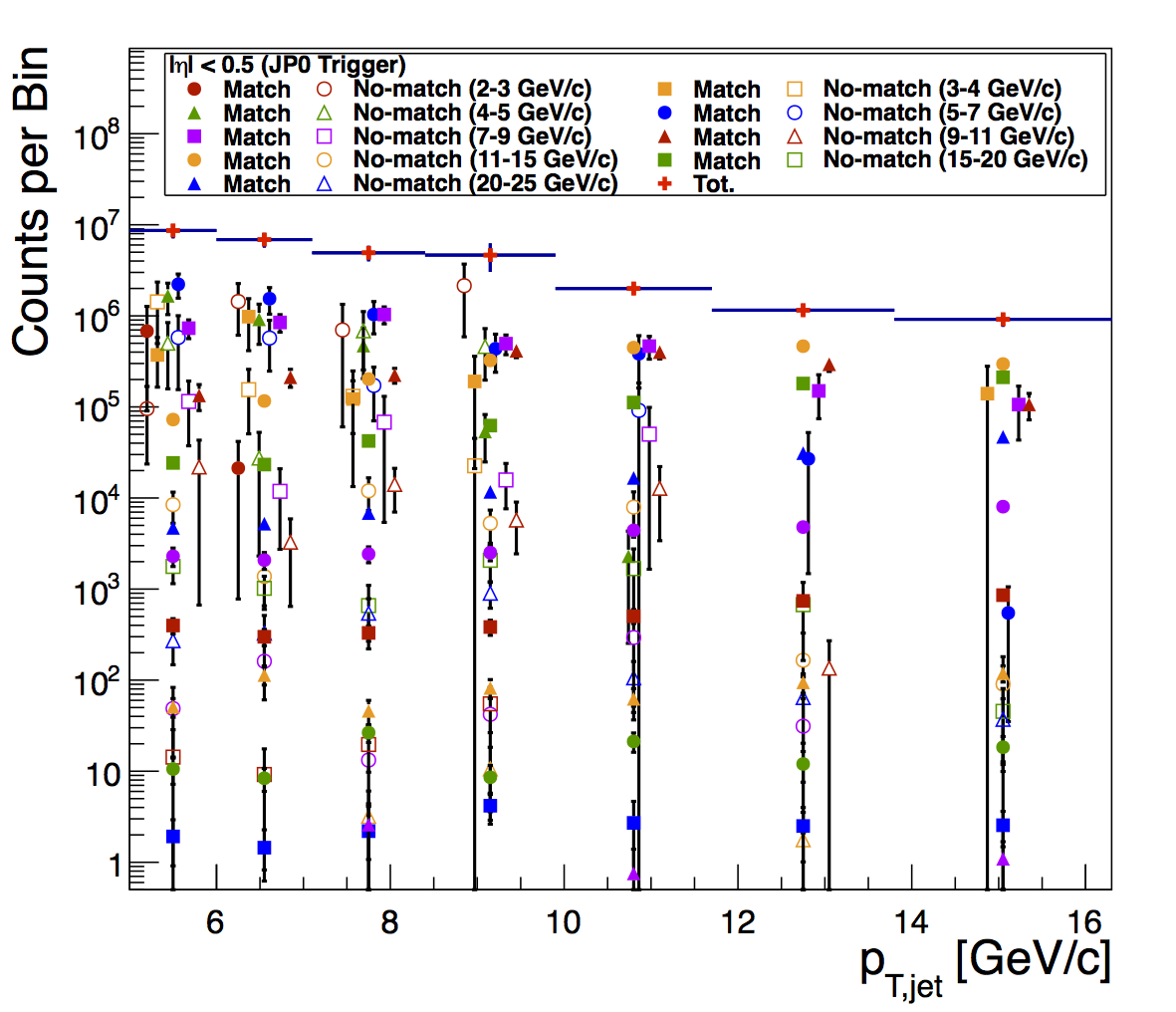

Again, it appears the low matching fractions in JP0 are due to the contributions of the 2-3 GeV/c partonic-pT bin.
Figure 9: JP1

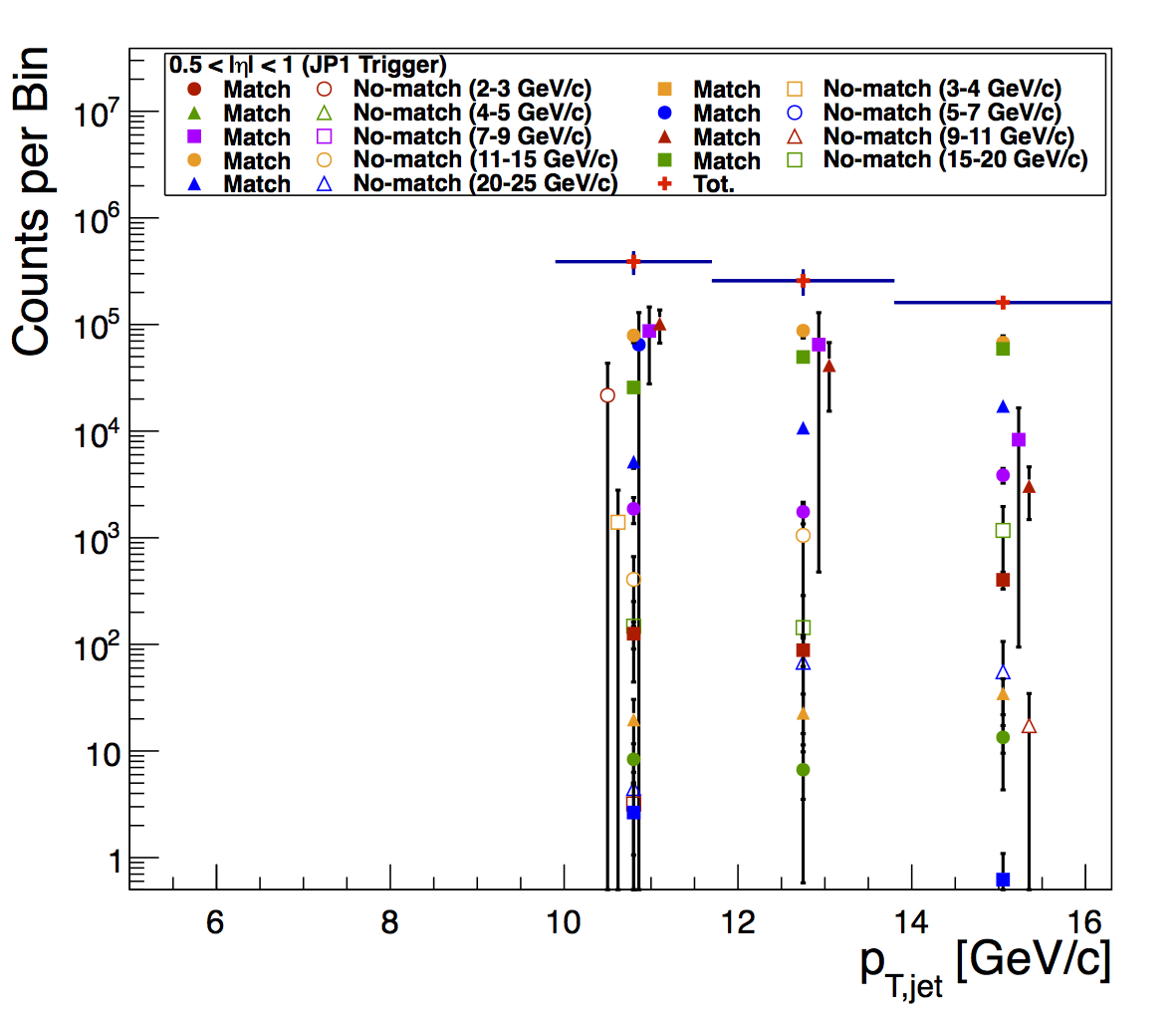
It appears that the leading contributor to the low matching fraction in JP1 is the 7-9 GeV/c bin. In the "forward" sample, the 2-3 GeV/c bin gives a single contributor with high weight. However, it appears we may have gotten lucky with a single matched 5-7 GeV/c jet to offset this.
- drach09's blog
- Login or register to post comments
